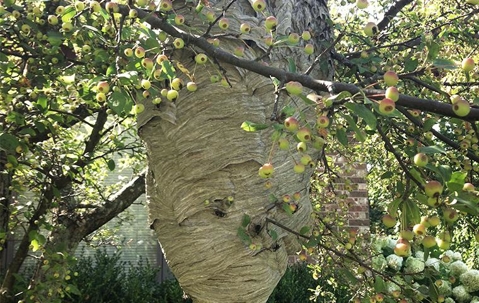Description
The bald-faced hornet isn’t actually a true hornet but an aerial yellow jacket. It’s easy to identify these stinging insects since it’s Michigan’s only black and white yellow jacket. It gets its name from the black and white marking on its face, thorax, and abdomen. They range in size from 12mm to 15mm, with queens being bigger, ranging from 18mm to 20mm.
Sting
Despite their large size (bigger than yellow jackets), bald face hornets are less aggressive compared to yellow jackets. However, they are still able to sting multiple times because of their smooth stinger. Most stings from bald face hornets are a result of their nest being disturbed or threatened.
Life Cycle
A single, over wintering queen begins building the nest in the spring. She lays eggs and tends the first batch of larvae that develop into workers. These workers tend new larvae and expand the nest throughout the summer. Their diet in the early spring and summer consists mostly of protein in the form of live prey such as flies, other yellow jackets, and many other types of insects. As the season starts to come to an end there’s less protein to feed the larvae. Workers then start to feed on nectar and other sources of carbohydrates.
Nest
Its nest is a gray “paper” envelope with several layers of combs inside. A mature nest is bigger than a basketball, but pear-shaped, with the larger end at the top and an entrance hole near the bottom. Towards the end of summer, nests can have anywhere from 300 to 500 workers. The nest is constructed by the bald face hornets collecting cellulose from weathered and rotting wood. They then chew the wood fibers and mix their saliva, creating a paste material used to make the paper nest. The majority of the time here in Michigan you’ll find them nesting in trees. They can also be found on building overhangs, in low shrubbery, and in attics. Having problems with a bald face hornet nest or think you have one, but can’t get close? Give us a call for home pest control at (810) 216-5062.
Learn more about our stinging insect control solutions in Port Huron.

